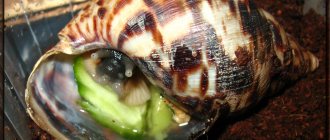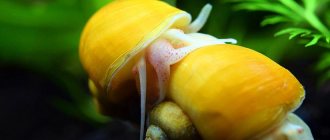The French have always been a little more adventurous than other Europeans. And when it comes to their national cuisine, the first thing that comes to mind is snails. Yes, it was the French who taught the whole world to enjoy shellfish dishes. At least, this is what most of our contemporaries think. Although in fact these gastropods were used as food back in ancient times.
general characteristics
Snails can be found, perhaps, in any corner of the planet, and in terms of the number of species they are second only to insects. They belong to the class Gastropods, which includes land snails, freshwater snails, sea snails and slugs. Their ancestors are among the most ancient species of the animal world. Archaeologists say that the first gastropods lived on our planet 500 million years ago.
Content:
- general characteristics
- Mollusks in world culture
- Species of gastropods
- Useful material
- Beneficial features
- Snails on a plate
- How to cook snails
- Gastropods in cosmetology
Representatives of gastropods are able to adapt to a wide variety of living conditions. They don't require much food. Slugs differ from snails only in that they lack an exoskeleton (“house”). Representatives of different species of land snails can differ significantly from each other, in particular in size. Some representatives of the species do not even reach 10 mm, while giant individuals live on the African continent - more than 30 cm.
Most snails move very slowly - about 1 mm per second, leaving behind a trail of mucus. It is thanks to mucus that gastropods are able to move on almost any surface without damaging themselves. They are completely deprived of hearing, but their vision and acute sense of smell, which is the main thing for these animals, allow them to navigate the terrain. The snail’s “house” “grows” with it and finally hardens when the gastropod reaches adulthood.
Another unique thing about these animals is that they are hermaphrodites. That is, each snail combines male and female genital organs, and after mating, both partners lay eggs.
The average lifespan of gastropods varies from 2 to 7 years. But in captivity they can reach 15 years of age (some can live for almost a quarter of a century).
Brief characteristics and description of African snails
In their natural habitat, these creatures are considered dangerous pests that affect many crops, but now people often keep Achatina as pets.
These snails are native to Africa. They are often found in regions with tropical and subtropical climates, where high humidity and sufficient plant food are maintained throughout the year. There are at least 60 varieties of these creatures. The animal's body is soft. The shell has an oblong, pointed shape. It reaches 30 cm. The color of the “house” can be:
- swamp;
- black-brown;
- brown with dark stripes, etc.
In addition, snails with white shells are relatively rare. They are smaller in size. Some individuals have yellow markings. The color scheme of the shell largely depends on the diet.
In most cases, it darkens with age. The shell of these creatures is always twisted counterclockwise. In adults, it includes from 7 to 10 turns. The weight of these creatures can range from 0.3 to 0.45 kg. The body of this creature is beige or dark brown.
Achatina has well-developed sense organs.
The eyes, located on long horns, are able to recognize lettuce at a distance of 1 m. In addition, these creatures have a developed sense of smell, allowing them to identify food located at a distance of 1.5 m. These snails have a well-developed memory, so they are able to remember the owner and distinguish him from other people.
Mollusks in world culture
In the modern world, the role of snails is usually limited to culinary purposes. But it was not always so. In the past, some peoples considered gastropods to be “unclean” animals that were of no use. The same cannot be said about the ancient Greeks, who used snails to determine the time of harvest: they saw “houses” on the stems - which means the gods allowed them to reap the fruits. For the ancient Babylonians and Egyptians, snails were a symbol of eternity, and the Aztecs generally idolized this mollusk - they considered it the god of the moon. The first information about the consumption of these gastropods for food also dates us back to antiquity. It is known that the ancient Romans did not disdain snails, and this protein-rich meat appeared equally often on the plates of the nobility and the poor.
A variety of snails Achatina used for food
All types of African snails are used in cooking in their homeland. In Europe and Japan, two types of land mollusks are eaten: Achatina fulica and Achatina achatina.
These snails reach enormous sizes, with average specimens reaching the size of a human palm. These mollusks are prolific and easy to care for. They are bred and harvested on special farms. Other types of African snails can be eaten, but most often they are kept as ornamental pets.
Species of gastropods
There are about 90,000 species of snails, but only 3 species have gained worldwide fame: the giant African snail, the grape snail and Helix Aspersa.
African giant
Achatina, or the giant African snail, is one of the largest representatives of land mollusks. Adult representatives of this species can exceed 30 cm in length. If the external temperature drops below 2 degrees Celsius, Achatina hides in its conical-shaped house and hibernates. But on particularly hot summer days, the animal can also fall asleep, escaping from excessively high temperatures. Interestingly, in case of severe drought, African giants can sleep in the “house” for up to 3 years.
The homeland of Achatina is Africa. But biologists have noticed that these creatures feel quite well on the islands of the Caribbean and the Pacific Ocean. Meanwhile, in foreign territory, these herbivorous migrants cause a lot of trouble for agriculture. What frightens farmers even more is the fact that Achatina reproduces very quickly: one snail lays about 200 eggs each time, almost 1200 a year.
In world cuisine, Achatina meat is not considered edible. First of all, due to the high risk of becoming infected with parasites. Meanwhile, this danger does not stop the inhabitants of Africa. They eat Achatina themselves and sell the meat of giant mollusks to tourists.
French delicacy
But one that does not require any special introduction is the grape or garden snail (Helix Pomatia). It is this species that is most often found in our gardens, orchards, and parks. And it is these gastropods that are the hallmark of French cuisine. It is Helix Pomatia that gourmets eat with gusto in the best restaurants in Europe, calling them Roman or Burgundy snails.
The largest populations of grape clams have been seen in Austria, Belgium, Germany, Romania, Spain, Ukraine, Great Britain, Luxembourg and several other countries on the continent. Meanwhile, these edible snails, being very unpretentious, are already successfully colonizing the countries of Asia, Africa, Oceania and America. For a comfortable life, they need moderate sun and high humidity.
Helix Aspersa
This type of snail is one of the most famous in Europe. On the one hand, Helix Aspersa has earned the reputation of a garden pest, and on the other hand, it is revered as a mollusk with important healing properties. Their yellow or cream shells rarely exceed 3-4 cm. Previously, Helix Aspersa was difficult to find outside their natural range (Western Europe, North Africa, Middle East). But recently, these gastropods have been actively exploring the territories of the USA, Canada, Mexico, Argentina, Chile, South Africa, and New Zealand, where they are believed to have arrived along with cargo transportation. One Helix Aspersa lays about 500 eggs per year.
This type of snail is also considered edible. However, Helix Aspersa gained its main popularity and application in the field of cosmetology.
Keeping at home: terrarium and climate
These snails do not require the creation of specific conditions. They can be kept in a terrarium in any apartment or house. At the same time, it must be taken into account that it is desirable for these creatures to create conditions close to natural. To keep one individual you will need an aquarium or terrarium made of plastic or glass with a volume of 5 liters. The larger the container, the faster and larger the clam will grow.
The snail's home must have a lid with holes for ventilation, because... These creatures can easily move along the walls. The bottom of the terrarium should be sprinkled with a special substrate or peat. You can also use soil, but then the snails and the walls of the container will always be dirty. The thickness of the litter should reach 4-7 cm, because snails love to burrow into it.
In the terrarium you can place decorative clay pots, shards and driftwood, under which the snails can hide. You can plant moss, fern or ivy. It is allowed to place artificial plants in the container, because natural ones can be eaten by snails. In the terrarium you need to place a feeder with low sides and a drinking bowl. The temperature in the container should be about +20..+25 °C. Air humidity should be 70-85%. The terrarium should not be exposed to direct sunlight. The backlight should be moderate.
Useful material
Biologists have calculated that the average snail is 80% water, 15% protein and 2.4% healthy fat. In particular, the meat of these shellfish contains essential fatty acids, calcium, iron, selenium, and magnesium. They are rich sources of vitamins A, E, K and B12.
Snails are an ideal option for a fat-burning diet. The calorie content of a 100-gram serving does not exceed 90 kcal. At the same time, the delicacy will provide the maximum amount of proteins (approximately 16.5 g) and the minimum dose of carbohydrates (no more than 2 g).
Regarding fats, nutritionists have calculated that a serving of gastropods contains less than 2 g of fat. But the main advantage is not even this, but the high content of omega-3 fatty acids. For example, snails contain eicosapentaenoic acid (almost 120 mg per 100 g of product), which is one of the main components of omega-3. Cardiologists recommend consuming 250 mg of fatty acids from shellfish daily to reduce the risk of cardiovascular disease.
If we talk about the vitamin and mineral composition, then 100 g of snails is:
- 3.5 mg of iron (which is more than in beef);
- 250 mg magnesium (which is much more than in beef, pork, chicken or fish);
- 382 mg potassium;
- 272 mg phosphorus;
- 70 mg sodium;
- 10 mg calcium;
- 1 mg zinc;
- 0.4 mg copper;
- 27.5 mcg selenium;
- 0.5 mcg vitamin B12;
- 0.1 mg vitamin B6;
- 100 IU vitamin A;
- 5 mg vitamin E;
- 0.1 mcg vitamin K;
- 0.1 mg riboflavin;
- 1.4 mg niacin;
- 6 mcg folic acid;
- 65 mg choline.
Fried snails with rosemary, Cretan style
You will need 500 g of boiled shellfish, half a glass of oil (olive oil is best), 2 tbsp. l. wine vinegar and a few leaves of chopped rosemary (1 tbsp.). You can salt and pepper the dish to taste.
- Salt is poured onto the bottom of a hot frying pan.
- Then the prepared mollusks are laid out with their mouths facing down.
- After the shells dry, they begin to fry them in oil for about 3 - 5 minutes. (pre-mix).
- After adding vinegar and herbs, the snails are stirred again, then turn off the heat.
When serving, the finished product is poured with the remaining oil from frying. You should remove the meat from the shells using a toothpick (the dark tip is removed, and the rest is eaten whole).
Beneficial features
Hippocrates also wrote about the benefits of snails for human health. The ancient Greeks noticed that the mucus left by gastropods smoothes scars and is useful for treating skin diseases. Over time, scientists confirmed that Hippocrates was right. The mucus contains substances that act on humans as antioxidants and anti-inflammatory agents. In addition, the secretion secreted by snails is believed by researchers to be the only natural source of copper peptide, a substance that eliminates scars. The gastropod secretory fluid has also been observed to be effective against warts and age spots. In addition, gastropod mucus has been used since ancient times to treat bronchitis, whooping cough and other diseases of the respiratory system.
The meat of these mollusks contains a glycoprotein, and it is believed to have anti-cancer properties. Snail dishes are also considered beneficial for people with cardiac problems.
Top 5 benefits
Snails are an excellent source of lectin, which has anti-cancer properties and stimulates the immune system.- The mucus of these gastropods is rich in allantonin, collagen and elastin - components important for the treatment of skin diseases and bone fractures. Copper peptide from shellfish secretions helps smooth out scars.
- The secretion secreted by these mollusks is an important source of oligosaccharides. In addition, this liquid treats acne, moisturizes the skin, improves its color, and protects against adverse environmental influences.
- Sea snails contain a specific substance that is beneficial for people suffering from depression, Parkinson's disease or drug addiction.
- In the bodies of slugs with “houses”, scientists have discovered a substance that stimulates the production of dopamine (the so-called happiness hormone) in people with neurological disorders.
Who benefits from eating snails?
Snail meat is considered a dietary and easily digestible product, so it is recommended to all people who are overweight or have metabolic disorders due to various reasons.
There are problems with joints and bones. Snail meat is used in the treatment of the gastrointestinal tract, pancreatitis and cholecystitis. Doctors around the world recommend that pregnant women, elderly people and young children eat snail meat several times a week. Achatina snail meat contains twice as much easily digestible protein as chicken meat. In many dishes, snail meat easily replaces beef and poultry.
Delicious snail meat dishes also have a beneficial effect on our nervous system, calming and stabilizing it.
Achatina meat is tender and elastic, has an unusual taste and aroma. Served with champagne or dry wine.
Snails on a plate
People have been eating snails for thousands of years. These crawling “houses” (mostly of the grape variety) have long become part of various national cuisines. Many consider them a tasty and nutritious option for a snack or main course. But, perhaps, the main lovers of snails are the French. Their signature dish is gastropods with garlic, spices and butter. Italians and Greeks will offer guests “houses” with a variety of sauces as a complement to pasta. Gourmets from Spain, Portugal, Germany, and America will not refuse dishes from gastropods.
Every year, people around the world eat millions of kilograms of snails. And the French annually celebrate Escargot Day (a dish made from gastropods) on May 24th. But despite the high popularity of this dish, improperly prepared land shellfish can cause poisoning or a more serious illness caused by parasites. Snails living in the wild require especially careful treatment. Some of them can carry parasites that cause meningitis.
Cooking snails the Burgundian way
You will need about 30 pieces of grape clams without shells (they can be fresh frozen or canned). You also need to prepare 50 g of Parmesan cheese, 100 g of butter, 3 - 4 cloves of garlic. Various seasonings (green parsley, nutmeg, salt) can be added to taste.
Greens and garlic are added to the chopped nuts, after which it all needs to be salted and mixed with soft butter. The shellfish are placed in small baking dishes. And then put a little butter and grated cheese on each of them.
Baking snail meat should take place at +320 C for about 10 minutes. It is served with dry wines and baguette.
How to cook snails
To taste the taste of snails, you don’t have to look for a French restaurant and pay a tidy sum for the delicacy. It is quite possible to prepare traditional escargot yourself. The “raw materials” for the dish can be bought at the supermarket (some sell frozen snails), or you can collect the slugs yourself. By and large, snails from expensive restaurants are no different from those that we see almost every day in our yards. The only thing is that before cooking “wild” gastropods, it is advisable to “cleanse” their stomach. And then everything is according to the recipe. And you will have escargot with garlic sauce, like the French chefs.
So, the first stage is to collect the desired number of grape snails. The easiest time to do this is in the morning (while the dew has not yet dried) or after rain. The snail hunting season usually lasts from April to September.
The second stage is the cleansing of gastropods. In order to cleanse the intestines, animals are put on a 3-day fast. To eliminate the bitter taste, you can feed them regular flour.
At the third stage, it is important to thoroughly rinse the snails under running water and place them in a bowl with table salt for a while. Then rinse thoroughly again to remove mucus and place in boiling water for 2-3 minutes. Rinse the boiled snails with water one last time, and you can start preparing the main dish (or put them in the freezer until better times).
Three ways to cook escargot
There are several classic ways to prepare escargot:
- frying;
- cooking;
- stuffed snails.
You can fry snails outdoors (over a fire on a grill) or at home in a deep frying pan using olive oil. The snails are placed in a frying pan with the holes facing up and fried over low heat. To improve the taste, add a little white wine during cooking.
Boiled snails are prepared in several stages. To begin, prepared slugs are soaked in vinegar for 12 hours. Then they are washed and placed in boiling water. While the clams are cooking, you can prepare the traditional savory sauce. To do this, fry onions, garlic, tomatoes and herbs in olive oil, add white wine to the mixture. Place the finished snails in a saucepan with the sauce (the liquid should cover the “houses”) and simmer everything together for a few more minutes.
Stuffed snails are the most difficult to prepare, but the dish is worth a little tinkering with it. Remove the pre-boiled snails from their shells and continue cooking (but in water with spices). Also boil empty shells in water and soda. The “houses” are stuffed with a filling of butter, garlic, parsley, pepper and other spices, and, of course, with the animal’s leg itself (after cutting out the dark area with the intestines from it). If desired, you can prepare any other filling.
Snails in Maltese
Cooking grape snails at home the Maltese way is as follows.
- You need to take 500 g of shellfish, which were previously boiled for 3 - 5 minutes, 200 ml of wine (red, dry), fresh herbs (mint, marjoram, basil). The amount of salt and pepper depends on personal preference.
- The shells with snails are quickly fried in oil (preferably olive oil). Then pour red wine into the frying pan, add salt and pepper.
- Further preparation of the snails takes place over low heat, where they should be stewed for 10 - 15 minutes.
- 1 - 2 minutes before complete readiness, add chopped greens to the dish.
- This treat is served directly in the shells, previously sprinkled with the remaining sauce.
Dry red wines can be replaced with ale if desired.
Snail fork - unusual cutlery
Snail devices are quite unusual, so it is quite easy to recognize them among others. There are three in total:
- fork with two prongs;
- tongs to hold the shell;
- flat escargot bowl made of metal.
Etiquette allows you to hold the shell with your hands rather than with a special device, but for the sake of aesthetics it is still better to use tongs. They are shaped like two spoons facing each other. They need to grab the sink and carefully remove the contents with a fork.
For an at-home dinner party, a full set of cutlery will look impressive. Although, guests may have to explain the purpose of the cutlery and the process of eating this delicacy. Otherwise, there is a risk of a situation arising, as with the heroine of Julia Roberts in the film “Pretty Woman”. The girl tried to pull the clam out of the shell, but it jumped out of her hands and flew straight into the waiter.
Watch from 2:30 - the very moment we talked about above.
Snails have a strong enough flavor that they don't require any special sauce. Lemon is served only with live oysters, but finely chopped greens are suitable for any shellfish dish. For drinks, you should give preference to chilled white wine. The ideal option would be Muscat, Tokaj and Chablis.
Popular articles
Grape snail salad
Some people consume boiled shellfish directly in this form, without even suspecting that they can be used to prepare gourmet dishes. But let's start with something simple.
First of all, you need to learn how to properly cook snails, and do it according to the method indicated above. Next, the shellfish meat is removed from the shells and finely chopped. A hard-boiled egg and fresh cucumber, chopped in the same way, are added to it. The prepared ingredients are mixed, after which the salad is dressed with mayonnaise. Add salt, pepper and any herbs to taste.
French traditions
To avoid awkward situations and not to embarrass customers, waiters in restaurants most often serve snails open, with the “attachment” muscle trimmed.
It is enough to sprinkle the shellfish with lemon juice and put it in your mouth, pricking it on a special cutlery - a special fork with two teeth.
Ready oysters are always eaten with the following utensils: dessert ones are used for cold ones, and table ones are used for hot ones. Problems usually arise with how to eat a snail in its shell. For this, there are escargot tweezers - special tongs with which the snail is removed from the “house”.
Here’s a “gentleman’s set” – everything for snails!
Many people believe that snails can only be eaten during the months that have the letter “r” in their names – from September to April. This misconception came to us from France. There, in order to avoid uncontrolled fishing of snails and their complete extermination, a law was passed prohibiting fishing during their breeding season. It just falls at the end of spring and throughout the summer. In addition, during the breeding season, milk appears inside the mollusks, giving the meat a bitter taste.
Today, this problem has lost its relevance, as experts have developed a method that allows the breeding period to be shifted by a couple of months. So in summer the meat is no longer bitter. In addition, when it is summer in Europe, in Australia it is winter and local snails do not even plan to reproduce.
The French have entire rituals explaining how and in what order to properly consume snails. Special devices have been invented for this. Most often, shellfish are served with butter and baguette, white bread or already cut, in a clay frying pan with special indentations.
Snails are usually served with dry white wine or brut champagne, which emphasizes but does not overshadow the taste of the delicacy. Unlike oysters, snails are not eaten alive; most often they are served fried, baked or boiled.
Their benefits
Like oysters, grape snails are considered a very healthy product and a source of high-quality protein.
Fresh snail meat contains:
- 10-17% proteins;
- 20-30% fat;
- 5-12% carbohydrates;
- vitamins and mineral elements: B vitamins, iron, calcium, magnesium, etc.
Figure 3. These are the dishes that can be prepared from grape snails, which also affects the nutrient content of the final product.
Specific numbers depend on the variety and food they eat, as well as on the method of their preparation (Figure 3).











